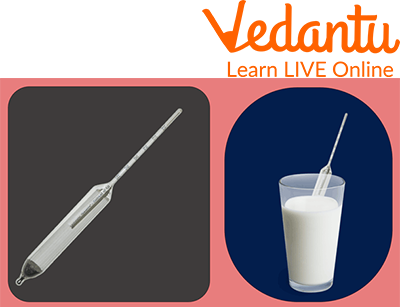




Milk Measurement: What is It and Its Unit?
Imagine there is freezing weather outside, so you have a cup of hot milk. You boiled the milk and started pouring it into a glass. You continued pouring and pouring, even though the glass was full. What was the result then? Milk is being splashed all over the table. What did you learn from this experience? Here, you learned about capacity. Capacity limits how many litres or Mililiters a container would hold. You can put the milk in a container at most its capacity. In this article, we will learn about milk measurement and the milk measurement equipment name.

Milk Overflowing from a Glass.
What is Milk Measurement?
The milk measurement is how much milk a vessel contains and its measurement in standard units. We additionally refer to it as the "limit" or the "volume" of the vessel. Let's say below we have 2 containers.

Capacity Comparison of Two Containers
Which container do you think would hold more milk, container 1 or 2? Container 2 as it is bigger than the 1st one. By looking at the size, we can judge that container 2 can hold more. So through this example, it is known that the process of identifying the capacity of any milk in a container is called milk measurement.
Milk Measurement Unit
We measure the milk in litres and millilitres. Litres are represented as l, and millilitres are represented as ml. Litres have greater capacity than millilitres. For example, below is the image of a milk bottle in 500, 250, 200 and 100ml. We could see that 500ml, which is half a litre of a milk bottle, holds more milk than the other three, so this has a greater capacity.
Millilitre and Litre Milk Measurement
A litre is a unit for measuring volume in a metric system 1 litre = 1000 millilitres. If the capacity of a container is 5 litres, it is written as 5 l. The milk measurement unit used by the milkman is litres.
A millilitre is denoted as ml or mL, a unit of volume in the metric system. Also, 1000 millilitres= 1 litre, or 1 cubic centimetre. For measuring a small quantity of milk, millilitres are used. For example, kids' milk bottles have millilitres on them to feed controlled amounts of milk.

Metric Measurement Comparison of Milk Bottles.
How Do We Do Milk Measurement?
Pitchers: We measure milk by measuring pitchers. The pitcher has markings starting from 100 ml to 700 ml, depending upon size. These are used to put a controlled amount of milk into something and are commonly used in the dairy industry.
Measuring cup: It is a utensil that also comes with markings on them starting from 50 ml. It is widely used To pour controlled amounts of milk for cooking various dairy foods such as pastries, cookies, and chocolates.
Measuring spoons or droppers: This is the smallest measurement used for milk, particularly used in science for conducting experiments that require one or a half tablespoons or even less milk.
Milk Measurement Equipment Name

Lactometer
A lactometer could be defined as an instrument or a device used to measure the purity of milk by measuring its density. Density means the creaminess or richness of milk. We could identify how much water is mixed in the milk through this device. To use this device, first dip it into the milk. There is a marking on the lactometer denoted as M, which shows the purity of milk. If your device sinks up to the mark, it means the milk is pure, and if the milk is impure, it will sink above mark M.
Mind-blowing Facts About Milk
The typical American polishes off very nearly 25 gallons of milk a year.
The most prominent measure of milk created in one year was 59,298 pounds by a Holstein cow named Robthom Sue Paddy.
In old societies, milk was considered the 'food of the divine beings.
Cows that are draining eat 100 pounds of feed and drink between 30 and 50 gallons of water daily.
One 8-ounce glass of milk gives eight grams of protein. Milk is a "complete" protein, a blend of amino acids.
Regardless of its rich surface, milk is 85-95% water. The remainder of its volume comes from nutrients, proteins, starches, and fat.
Summary
This article aimed to explain how to use milk measurement to identify the amount of milk in a container. We measure it in standard units, which are litres and millilitres. We also learned how milk is measured using pitchers, cups, and spoons. Furthermore, we learned about using a lactometer to find the purity of milk. By using this device, we can know whether the quality of the milk is good for our health or not. We hope this article has given insights into the measurement of milk.
FAQs on Milk Measurement
1. Why isn't milk measured in kilogrammes?
Standardising measurements means that liquids are measured by how much space they take up, and solids are measured by their weigh. Since milk is a liquid, its volume is measured in millilitres (ml), not kilograms (kg).
2. How does a milkman do the measurement of milk?
The milkman utilises various jars to measure the milk, like 1 l, 500 ml, 200 ml, 100 ml, 50 ml, and so forth. Different sorts of estimating containers are used to measure various fluids.
3. Which is more, 1 kg or 1 litre?
The kilogram has more mass than the litre because a litre is a unit of volume, not mass, and a kilogram is a measure of mass. Additionally, volume is greater than mass, meaning 1 litre is more than 1 kg.











